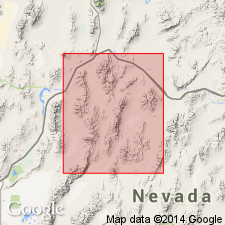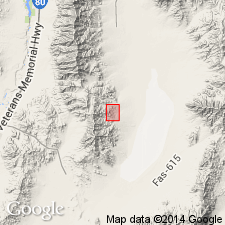
- Usage in publication:
-
- Fossil Hill Member
- Modifications:
-
- Named
- Dominant lithology:
-
- Limestone
- Mudstone
- Siltstone
- Shale
- AAPG geologic province:
-
- Great Basin province
Summary:
Unit is named Fossil Hill Member of Favret Formation of Star Peak Group. Consists of dark-gray, yellowish-brown, pinkish-gray, fossiliferous, flaggy, laterally discontinuous beds, platform carbonate deposit of interstratified limestone, calcareous mudstone, siltstone, and shale. Thickness is 60 m (up to 200 m). Disconformably overlies unnamed lower member and gradationally underlies unnamed upper member of Prida Formation of Star Peak Group. At China Mountain, underlies Panther Canyon Member of Augusta Mountain Formation. Age is Middle Triassic (Anisian and Ladinian).
Type section: south side of Fossil Hill, in NW/4 SE/4 sec. 19, T. 28 N., R. 35 E., southeast Humboldt Range, Pershing Co., NV. Named from Fossil Hill, Humboldt Range, NV.
Source: GNU records (USGS DDS-6; Menlo GNULEX).

- Usage in publication:
-
- Fossil Hill Member*
- Modifications:
-
- Biostratigraphic dating
- AAPG geologic province:
-
- Great Basin province
Summary:
Fossil Hill Member or Formation of the Star Peak Group is adopted as defined by Nichols and Silberling (1977). Is the upper member of the Favret Formation in the southern Tobin Range and Augusta Mountain; middle member of the Prida Formation in the Humboldt and northern East Ranges; Fossil Hill Formation at China Mountain and in the southern Augusta Mountain. Is composed of fissile to flaggy, dark-gray, calcareous shale with concretionary fossiliferous lime-mudstone interbeds. Thickness is 200 m. Age is Middle Triassic (Anisian) based of fossils [cephalopods].
Source: GNU records (USGS DDS-6; Menlo GNULEX).
For more information, please contact Nancy Stamm, Geologic Names Committee Secretary.
Asterisk (*) indicates published by U.S. Geological Survey authors.
"No current usage" (†) implies that a name has been abandoned or has fallen into disuse. Former usage and, if known, replacement name given in parentheses ( ).
Slash (/) indicates name conflicts with nomenclatural guidelines (CSN, 1933; ACSN, 1961, 1970; NACSN, 1983, 2005, 2021). May be explained within brackets ([ ]).

